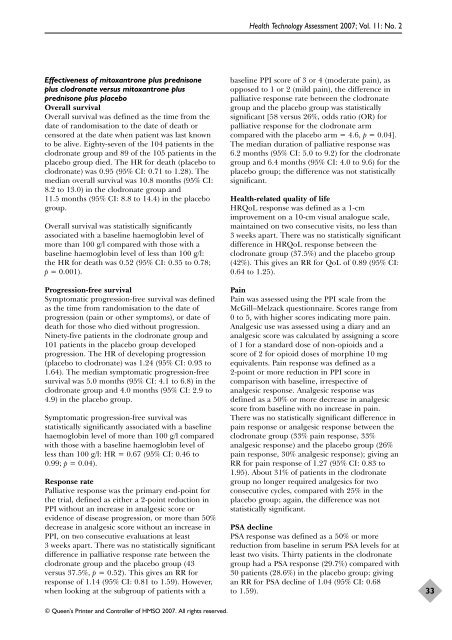Docetaxel with prednisone or prednisolone for the treatment of ...
Docetaxel with prednisone or prednisolone for the treatment of ...
Docetaxel with prednisone or prednisolone for the treatment of ...
Create successful ePaper yourself
Turn your PDF publications into a flip-book with our unique Google optimized e-Paper software.
Effectiveness <strong>of</strong> mitoxantrone plus <strong>prednisone</strong><br />
plus clodronate versus mitoxantrone plus<br />
<strong>prednisone</strong> plus placebo<br />
Overall survival<br />
Overall survival was defined as <strong>the</strong> time from <strong>the</strong><br />
date <strong>of</strong> randomisation to <strong>the</strong> date <strong>of</strong> death <strong>or</strong><br />
cens<strong>or</strong>ed at <strong>the</strong> date when patient was last known<br />
to be alive. Eighty-seven <strong>of</strong> <strong>the</strong> 104 patients in <strong>the</strong><br />
clodronate group and 89 <strong>of</strong> <strong>the</strong> 105 patients in <strong>the</strong><br />
placebo group died. The HR f<strong>or</strong> death (placebo to<br />
clodronate) was 0.95 (95% CI: 0.71 to 1.28). The<br />
median overall survival was 10.8 months (95% CI:<br />
8.2 to 13.0) in <strong>the</strong> clodronate group and<br />
11.5 months (95% CI: 8.8 to 14.4) in <strong>the</strong> placebo<br />
group.<br />
Overall survival was statistically significantly<br />
associated <strong>with</strong> a baseline haemoglobin level <strong>of</strong><br />
m<strong>or</strong>e than 100 g/l compared <strong>with</strong> those <strong>with</strong> a<br />
baseline haemoglobin level <strong>of</strong> less than 100 g/l:<br />
<strong>the</strong> HR f<strong>or</strong> death was 0.52 (95% CI: 0.35 to 0.78;<br />
p = 0.001).<br />
Progression-free survival<br />
Symptomatic progression-free survival was defined<br />
as <strong>the</strong> time from randomisation to <strong>the</strong> date <strong>of</strong><br />
progression (pain <strong>or</strong> o<strong>the</strong>r symptoms), <strong>or</strong> date <strong>of</strong><br />
death f<strong>or</strong> those who died <strong>with</strong>out progression.<br />
Ninety-five patients in <strong>the</strong> clodronate group and<br />
101 patients in <strong>the</strong> placebo group developed<br />
progression. The HR <strong>of</strong> developing progression<br />
(placebo to clodronate) was 1.24 (95% CI: 0.93 to<br />
1.64). The median symptomatic progression-free<br />
survival was 5.0 months (95% CI: 4.1 to 6.8) in <strong>the</strong><br />
clodronate group and 4.0 months (95% CI: 2.9 to<br />
4.9) in <strong>the</strong> placebo group.<br />
Symptomatic progression-free survival was<br />
statistically significantly associated <strong>with</strong> a baseline<br />
haemoglobin level <strong>of</strong> m<strong>or</strong>e than 100 g/l compared<br />
<strong>with</strong> those <strong>with</strong> a baseline haemoglobin level <strong>of</strong><br />
less than 100 g/l: HR = 0.67 (95% CI: 0.46 to<br />
0.99; p = 0.04).<br />
Response rate<br />
Palliative response was <strong>the</strong> primary end-point f<strong>or</strong><br />
<strong>the</strong> trial, defined as ei<strong>the</strong>r a 2-point reduction in<br />
PPI <strong>with</strong>out an increase in analgesic sc<strong>or</strong>e <strong>or</strong><br />
evidence <strong>of</strong> disease progression, <strong>or</strong> m<strong>or</strong>e than 50%<br />
decrease in analgesic sc<strong>or</strong>e <strong>with</strong>out an increase in<br />
PPI, on two consecutive evaluations at least<br />
3 weeks apart. There was no statistically significant<br />
difference in palliative response rate between <strong>the</strong><br />
clodronate group and <strong>the</strong> placebo group (43<br />
versus 37.5%, p = 0.52). This gives an RR f<strong>or</strong><br />
response <strong>of</strong> 1.14 (95% CI: 0.81 to 1.59). However,<br />
when looking at <strong>the</strong> subgroup <strong>of</strong> patients <strong>with</strong> a<br />
© Queen’s Printer and Controller <strong>of</strong> HMSO 2007. All rights reserved.<br />
Health Technology Assessment 2007; Vol. 11: No. 2<br />
baseline PPI sc<strong>or</strong>e <strong>of</strong> 3 <strong>or</strong> 4 (moderate pain), as<br />
opposed to 1 <strong>or</strong> 2 (mild pain), <strong>the</strong> difference in<br />
palliative response rate between <strong>the</strong> clodronate<br />
group and <strong>the</strong> placebo group was statistically<br />
significant [58 versus 26%, odds ratio (OR) f<strong>or</strong><br />
palliative response f<strong>or</strong> <strong>the</strong> clodronate arm<br />
compared <strong>with</strong> <strong>the</strong> placebo arm = 4.6, p = 0.04].<br />
The median duration <strong>of</strong> palliative response was<br />
6.2 months (95% CI: 5.0 to 9.2) f<strong>or</strong> <strong>the</strong> clodronate<br />
group and 6.4 months (95% CI: 4.0 to 9.6) f<strong>or</strong> <strong>the</strong><br />
placebo group; <strong>the</strong> difference was not statistically<br />
significant.<br />
Health-related quality <strong>of</strong> life<br />
HRQoL response was defined as a 1-cm<br />
improvement on a 10-cm visual analogue scale,<br />
maintained on two consecutive visits, no less than<br />
3 weeks apart. There was no statistically significant<br />
difference in HRQoL response between <strong>the</strong><br />
clodronate group (37.5%) and <strong>the</strong> placebo group<br />
(42%). This gives an RR f<strong>or</strong> QoL <strong>of</strong> 0.89 (95% CI:<br />
0.64 to 1.25).<br />
Pain<br />
Pain was assessed using <strong>the</strong> PPI scale from <strong>the</strong><br />
McGill–Melzack questionnaire. Sc<strong>or</strong>es range from<br />
0 to 5, <strong>with</strong> higher sc<strong>or</strong>es indicating m<strong>or</strong>e pain.<br />
Analgesic use was assessed using a diary and an<br />
analgesic sc<strong>or</strong>e was calculated by assigning a sc<strong>or</strong>e<br />
<strong>of</strong> 1 f<strong>or</strong> a standard dose <strong>of</strong> non-opioids and a<br />
sc<strong>or</strong>e <strong>of</strong> 2 f<strong>or</strong> opioid doses <strong>of</strong> m<strong>or</strong>phine 10 mg<br />
equivalents. Pain response was defined as a<br />
2-point <strong>or</strong> m<strong>or</strong>e reduction in PPI sc<strong>or</strong>e in<br />
comparison <strong>with</strong> baseline, irrespective <strong>of</strong><br />
analgesic response. Analgesic response was<br />
defined as a 50% <strong>or</strong> m<strong>or</strong>e decrease in analgesic<br />
sc<strong>or</strong>e from baseline <strong>with</strong> no increase in pain.<br />
There was no statistically significant difference in<br />
pain response <strong>or</strong> analgesic response between <strong>the</strong><br />
clodronate group (33% pain response, 33%<br />
analgesic response) and <strong>the</strong> placebo group (26%<br />
pain response, 30% analgesic response); giving an<br />
RR f<strong>or</strong> pain response <strong>of</strong> 1.27 (95% CI: 0.83 to<br />
1.95). About 31% <strong>of</strong> patients in <strong>the</strong> clodronate<br />
group no longer required analgesics f<strong>or</strong> two<br />
consecutive cycles, compared <strong>with</strong> 25% in <strong>the</strong><br />
placebo group; again, <strong>the</strong> difference was not<br />
statistically significant.<br />
PSA decline<br />
PSA response was defined as a 50% <strong>or</strong> m<strong>or</strong>e<br />
reduction from baseline in serum PSA levels f<strong>or</strong> at<br />
least two visits. Thirty patients in <strong>the</strong> clodronate<br />
group had a PSA response (29.7%) compared <strong>with</strong><br />
30 patients (28.6%) in <strong>the</strong> placebo group; giving<br />
an RR f<strong>or</strong> PSA decline <strong>of</strong> 1.04 (95% CI: 0.68<br />
to 1.59).<br />
33
















